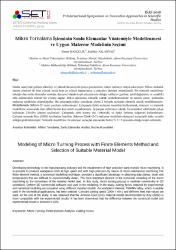| dc.contributor.author | Hasçelik, Ahmet | |
| dc.contributor.author | Aslantaş, Kubilay | |
| dc.date.accessioned | 2020-01-14T08:30:40Z | |
| dc.date.available | 2020-01-14T08:30:40Z | |
| dc.date.issued | 2018 | en_US |
| dc.identifier.citation | Hasçeli̇k, A., Aslantaş, K. (2018). Mikro Tornalama İşleminin Sonlu Elemanlar Yöntemiyle Modellenmesi ve Uygun Malzeme Modelinin Seçimi. International Journal of Multidisciplinary Studies and Innovative Technologies, 2: 30-33. | en_US |
| dc.identifier.uri | https://dergipark.org.tr/tr/pub/ijmsit/issue/40810/489766 | |
| dc.identifier.uri | https://hdl.handle.net/11630/8081 | |
| dc.description.abstract | İmalat sanayinde gelişen teknoloji ve yüksek hassasiyette parça gereksinimi, mikro işlemeyi ortaya çıkarmıştır. Mikro mekanik işleme yöntemi ile hem yüksek hızda hem de yüksek hassasiyette iş parçaları üretmek mümkündür. Bir nümerik modelleme tekniği olan sonlu elemanlar metodu, deneysel olarak tespit etmenin zor olduğu verilerin (gerilme, şekil değiştirme ve sıcaklık) elde edilmesinde önemli bir avantaj sağlar. Mikro işlemenin nümerik olarak modellenmesinde en önemli unsur, kullanılan malzeme modelinin doğruluğudur. Bu çalışmada mikro tornalama işlemi 2 boyutlu şartlarda nümerik olarak modellenmiştir. Modellemede Deform-2D ticari yazılımı kullanılmıştır. Çalışmada farklı malzeme modelleri kullanılarak, deneysel ve nümerik modelleme sonucunda elde edilen kesme kuvvetleri kıyaslanmıştır. İş parçası malzemesi olarak, biyomedikal sektöründe çokça kullanılan Ti6Al4v alaşımı seçilmiştir. Çalışmada sabit kesme hızı (100m/dk) ve farklı ilerleme değerleri kullanılmıştır. Çalışma sonunda Kay (2002) tarafından önerilen, Johnson-Cook (J-C) malzeme modelinin deneysel sonuçlarla daha uyumlu olduğu gözlemlenmiştir. Nümerik modelleme ile deneysel sonuçlar arasındaki farkın % 5-15 arasında olduğu tespit edilmiştir. | en_US |
| dc.description.abstract | Developing technology in the manufacturing industry and the requirement of high precision parts reveals micro machining. It is possible to produce workpieces both at high speed and with high precision by means of micro-mechanical machining.The finite element method, a numerical modelling technique, provides a significant advantage in obtaining data (stress, strain and temperature) that are difficult to experimentally detect. The most important element in the numerical modeling of the micro machining is; the correctness of the material model used. In this study, micro turning process is modeled numerically in 2D conditions. Deform-2D commercial software was used in the modeling. In the study, cutting forces obtained by experimental and numerical modeling are compared using different material models. As workpiece material, Ti6Al4V alloy, which is widely used in the biomedical applications, has been selected. Constant cutting speed (100m / min.) and different feed rate values are used. At the end of the study, it was observed that the Johnson-Cook (J-C) material model recommended by Kay (2002) is more compatible with the experimental results. It has been determined that the difference between the numerical model and experimental results is between 5-15%. | en_US |
| dc.language.iso | tur | en_US |
| dc.publisher | DergiPark | en_US |
| dc.rights | info:eu-repo/semantics/openAccess | en_US |
| dc.subject | Micro Turning | en_US |
| dc.subject | Finite Element Analysis | en_US |
| dc.subject | Cutting Forces | en_US |
| dc.subject | Mikro Tornalama | en_US |
| dc.subject | Sonlu Elemanlar Analizi | en_US |
| dc.subject | Kesme Kuvvetleri | en_US |
| dc.title | Mikro tornalama işleminin sonlu elemanlar yöntemiyle modellenmesi ve uygun malzeme modelinin seçimi | en_US |
| dc.title.alternative | Modeling of Micro Turning Process with Finite Elements Method and Selection of Suitable Material Model | en_US |
| dc.type | article | en_US |
| dc.relation.journal | International Journal of Multidisciplinary Studies and Innovative Technologies | en_US |
| dc.department | İscehisar Meslek Yüksekokulu | en_US |
| dc.authorid | 0000-0002-4615-0640 | en_US |
| dc.identifier.volume | 2 | en_US |
| dc.identifier.startpage | 30 | en_US |
| dc.identifier.endpage | 33 | en_US |
| dc.identifier.issue | 2 | en_US |
| dc.relation.publicationcategory | Makale - Ulusal Hakemli Dergi - Başka Kurum Yazarı | en_US |
| dc.contributor.institutionauthor | Hasçeli̇k, Ahmet | |
| dc.contributor.institutionauthor | Aslantaş, Kubilay | |



















